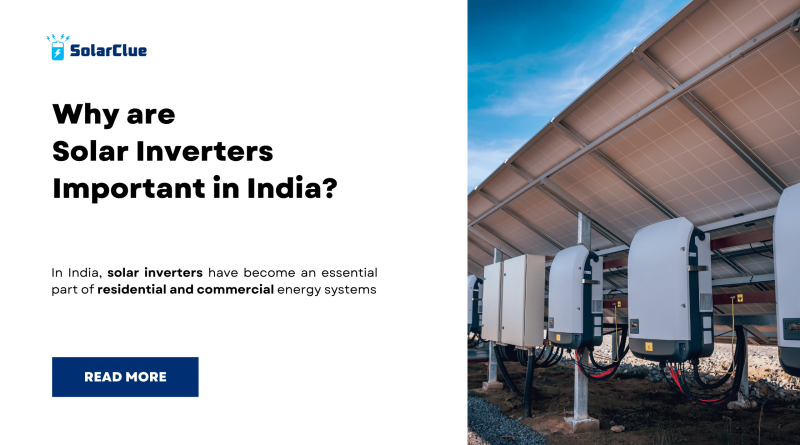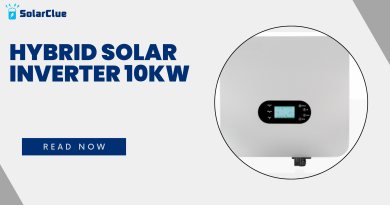Solar Inverter In India
Solar energy is gaining popularity in India due to the growing need for clean, renewable power and rising electricity costs. A solar inverter is a key component of any solar power system, as it converts the direct current (DC) generated by solar panels into alternating current (AC) that can be used by household appliances. If you’re considering switching to solar power, understanding how solar inverters work and which ones are best suited for Indian conditions is crucial. In this blog, we’ll explore everything you need to know about solar inverters in India and how they can help you save on energy bills while being environmentally conscious.
Table of Contents
- 1 What is a Solar Inverter?
- 1.1 Types of Solar Inverters in India
- 1.1.1 Why are Solar Inverters Important in India?
- 1.1.2 1. Energy Savings
- 1.1.3 2. Backup Power During Outages
- 1.1.4 3. Environmental Impact
- 1.1.5 4. Increased Property Value
- 1.1.6 5. Long-Term Investment
- 1.1.7 Popular Brands of Solar Inverters in India
- 1.1.8 1. Power Consumption
- 1.1.9 2. Battery Storage
- 1.1.10 3. Efficiency Rating
- 1.1.11 4. Grid Connection
- 1.1.12 5. Warranty and Support
- 1.1 Types of Solar Inverters in India
What is a Solar Inverter?
A solar inverter is a device that converts the DC electricity generated by solar panels into AC power. Most household appliances run on AC power, so this conversion is necessary for your solar system to power your home or business. Without a solar inverter, the electricity generated by your solar panels would be useless for daily activities.
There are different types of solar inverters available in India, each suited to different needs and setups. Choosing the right one depends on factors such as the size of your solar system, your power consumption, and whether or not you plan to use battery storage.
Types of Solar Inverters in India
There are three main types of solar inverters commonly used in India:
- On-Grid Solar Inverters: Also known as grid-tied inverters, these are connected to the public electricity grid. They allow you to use both solar energy and electricity from the grid. If your solar panels generate more electricity than you need, the excess can be sent back to the grid, and in some cases, you may even earn credits for it.
- Off-Grid Solar Inverters: These are stand-alone systems that are not connected to the electricity grid. They rely on batteries to store excess energy generated by the solar panels. Off-grid inverters are ideal for remote areas with no access to the public electricity grid.
- Hybrid Solar Inverters: As the name suggests, hybrid inverters combine the benefits of both on-grid and off-grid systems. They are connected to the grid but also include battery storage, making them a more versatile option for those who want both grid independence and backup power.
Why are Solar Inverters Important in India?
In India, solar inverters have become an essential part of residential and commercial energy systems for several reasons:
- Unreliable Grid Power: In many parts of India, especially rural areas, the grid power supply is unreliable, with frequent outages and voltage fluctuations. A solar inverter with battery backup can provide a steady supply of power, even during grid failures.
- Rising Electricity Costs: Electricity rates in India have been increasing steadily, making solar power a cost-effective alternative. By investing in a solar system with an efficient inverter, you can significantly reduce your electricity bills.
- Government Support: The Indian government is encouraging solar energy adoption through various subsidies and incentives. Solar inverters, as part of a larger solar system, are eligible for these benefits, making them more affordable for homeowners and businesses.
- Environmental Benefits: Solar energy is a clean, renewable source of power that helps reduce carbon emissions. By using solar inverters, you’re contributing to a greener, more sustainable future for India.
How Does a Solar Inverter Work?
Understanding how a solar inverter works is essential before investing in a solar system. Here’s a step-by-step breakdown of the process:
- Solar Energy Generation: Solar panels absorb sunlight and convert it into direct current (DC) electricity.
- Conversion to AC Power: The solar inverter converts the DC electricity into alternating current (AC), which is compatible with your home’s electrical system and appliances.
- Power Usage: The converted AC power is then used to run household appliances like lights, fans, refrigerators, and more.
- Surplus Energy Management: If your solar system produces more electricity than you need, the excess can either be stored in a battery (if using an off-grid or hybrid system) or sent back to the grid (if using an on-grid system).
Benefits of Using Solar Inverters in India
There are numerous benefits to using solar inverters in India, both for homeowners and businesses. Here are some of the most important advantages:
1. Energy Savings
One of the primary benefits of solar inverters is that they allow you to generate your own electricity, reducing your dependence on the grid. This can lead to significant savings on your electricity bills, especially in areas with high energy costs.
2. Backup Power During Outages
If you choose a solar inverter with battery storage or an off-grid system, you’ll have access to backup power during grid outages. This is especially useful in areas where power cuts are frequent.
3. Environmental Impact
Switching to solar energy helps reduce your carbon footprint. Solar inverters enable you to make the most of the energy produced by your solar panels, making your home or business more environmentally friendly.
4. Increased Property Value
Installing a solar inverter and solar panels can increase the value of your property. Many buyers see solar energy as a long-term investment that can help save money and reduce their environmental impact.
5. Long-Term Investment
Solar inverters, along with a well-designed solar system, can last for 15-20 years or more, making them a solid long-term investment. The initial cost may be high, but the savings over the years make it worthwhile.
Popular Brands of Solar Inverters in India
India has a range of solar inverter brands offering different features and price points. Here are some of the most popular brands:
- Luminous: Known for its reliability and wide range of inverters suitable for homes and businesses.
- Sukam: Offers both on-grid and off-grid solar inverters with innovative features.
- Microtek: A trusted brand with a variety of solar inverters for different power capacities.
- Tata Power Solar: Backed by Tata, this brand is popular for its high-quality and durable solar products.
Choosing the Right Solar Inverter for Your Needs
When choosing a solar inverter in India, there are several factors you should consider:
1. Power Consumption
Estimate your daily power consumption to determine the capacity of the inverter you need. If you have a small home or use limited appliances, a lower-capacity inverter (1kVA to 3kVA) may be sufficient. Larger homes or businesses may require inverters with a capacity of 5kVA or more.
2. Battery Storage
Decide whether you want to include battery storage in your system. While batteries increase the overall cost, they provide backup power during outages and allow you to store excess energy for later use.
3. Efficiency Rating
Check the efficiency rating of the inverter. Higher efficiency means that more of the electricity generated by your solar panels will be available for use, with less lost during conversion from DC to AC.
4. Grid Connection
Decide if you want a grid-tied, off-grid, or hybrid inverter based on your location and needs. If you live in an area with frequent power cuts, an off-grid or hybrid system might be more beneficial.
5. Warranty and Support
Always check the warranty provided by the manufacturer. A good warranty ensures peace of mind and indicates that the manufacturer is confident in the product’s quality.
Cost of Solar Inverters in India
The cost of solar inverters in India varies depending on the brand, capacity, and features. Here’s a rough estimate of the prices for different types of solar inverters:
| Inverter Type | Capacity | Price Range (INR) |
|---|---|---|
| On-Grid Solar Inverter | 1kVA to 3kVA | ₹15,000 – ₹35,000 |
| Off-Grid Solar Inverter | 1kVA to 5kVA | ₹20,000 – ₹60,000 |
| Hybrid Solar Inverter | 3kVA to 10kVA | ₹40,000 – ₹1,00,000+ |
These prices can vary based on additional features such as battery support, efficiency ratings, and the brand’s reputation.
Government Schemes and Incentives for Solar Inverters in India
The Indian government has introduced various schemes to promote the adoption of solar energy. Some of the key programs include:
- Subsidies on Solar Installations: The Ministry of New and Renewable Energy (MNRE) offers subsidies of up to 40% for solar rooftop installations, making it more affordable for homeowners.
- Net Metering: Through the net metering scheme, any excess electricity generated by your solar system can be fed back into the grid. You’ll receive credits for this power, which can reduce your overall electricity bill.
- Tax Incentives: Businesses that install solar energy systems can avail of tax deductions on their investments.
Conclusion
Switching to solar energy in India is an excellent way to reduce electricity bills and become more energy-independent. A solar inverter is the heart of any solar system, ensuring that the energy generated by your solar panels is usable by your appliances. Whether you live in a city or a rural area, a well-chosen solar inverter can help you take advantage of India’s abundant sunshine.
With various options available in the market, it’s important to choose the right solar inverter based on your energy needs, budget, and the type of system you want. The initial investment may be high, but the long-term savings, combined with government incentives, make solar inverters a worthy investment.
Visit SolarClue® to see the best Solar Inverters. SolarClue® actively sells solar energy products at discounts of up to 50% on its online marketplace.



